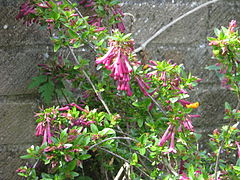en
names in breadcrumbs


Major pollen and nectar source
Linnaea floribunda, also known as Mexican abelia,[4] is a species of flowering plant in the honeysuckle family, Caprifoliaceae, native to Mexico.[1][3]
Growing to 4 m (13 ft) tall and broad, it is a semi-evergreen or evergreen shrub with shiny ovate leaves and clusters of tubular cerise flowers to 5 cm (2.0 in) long. The flowers bloom year-round (in the wild) except in the spring. It fruits (produces a seed pod) year-round (in the wild) except May and June.
Though hardy down to −10 °C (14 °F), it prefers a sheltered location, for instance against a south-facing stone wall.[4]
Under its other name Vesalea floribunda,[4] it has gained the Royal Horticultural Society’s Award of Garden Merit.[5][6]
It the wild in Mexico, its natural habitat is mixed Pine and oak forests and on rocky outcrops. Growing up to altitudes of between 2,000 to 3,000 m (6,600 to 9,800 ft) above sea level.[4]
Linnaea floribunda, also known as Mexican abelia, is a species of flowering plant in the honeysuckle family, Caprifoliaceae, native to Mexico.
Growing to 4 m (13 ft) tall and broad, it is a semi-evergreen or evergreen shrub with shiny ovate leaves and clusters of tubular cerise flowers to 5 cm (2.0 in) long. The flowers bloom year-round (in the wild) except in the spring. It fruits (produces a seed pod) year-round (in the wild) except May and June.
Though hardy down to −10 °C (14 °F), it prefers a sheltered location, for instance against a south-facing stone wall.
Under its other name Vesalea floribunda, it has gained the Royal Horticultural Society’s Award of Garden Merit.
It the wild in Mexico, its natural habitat is mixed Pine and oak forests and on rocky outcrops. Growing up to altitudes of between 2,000 to 3,000 m (6,600 to 9,800 ft) above sea level.

